Cities Are Made for Faith, and Vice Versa
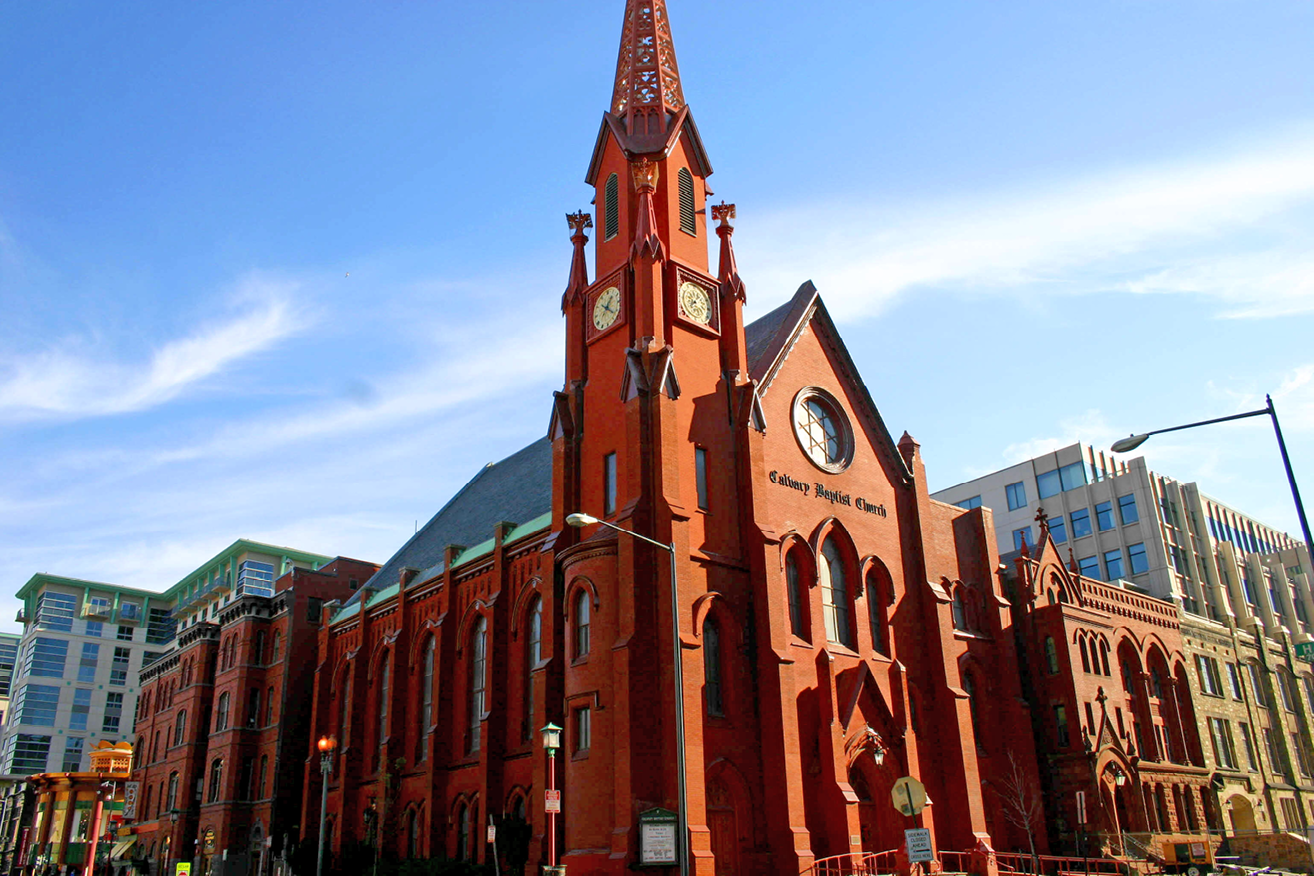
Calvary Baptist Church, Washington, DC (photo courtesy of Elvert Xavier Barnes Photography)
I grew up as a Bible-Belt Methodist, and my immersion in that culture had a profound and lasting effect in shaping my values. While I no longer adhere to a particular faith, I remain intensely interested in and comfortable with discussions of church teachings, particularly those related to ethics. This drew me to the work of a number of city-based religious practitioners and thinkers, whose views I profile in this essay. Although these theologians are Christian, I believe their urban values apply much more broadly.
I have an elusive relationship with religion. That’s probably not very unusual, given the inherent unknowability of it all. But I suspect those of us who carry around an uncertainty regarding things spiritual may experience it in very distinct ways.
I was raised as a Protestant Christian in western North Carolina, right in that part of the southeastern US where evangelical Protestantism thrives and church attendance is high. I went to revivals as a kid; there’s a Billy Graham Freeway in my hometown. Probably nine-tenths of my social life revolved around the Methodist church, one way or another. While I no longer observe religion in the same way as then—at this point, I would probably be some mixture of Unitarian Universalist and Buddhist if I practiced at all, which I don’t, generally—my religious upbringing had everything to do with my values of peace, justice, and stewardship.
I am who I am today because of who I was then.
It strikes me as odd that strongly-held religious beliefs have become associated with conservative politics in the US. For me, spiritual values remain essentially liberal ones: ethical practice means understanding and caring for others and showing decency and respect, not condescension. I know: easy to say, not always easy to do.
As a result, when I run across people of faith who are also environmental and urbanist leaders, I pay special attention. They are, in a sense, speaking in a language that is deeply embedded in my consciousness. When I hear of impressive faith-based initiatives for urban revitalization, such as those by Bethel New Life in Chicago, I’m rooting for them a bit harder than I might otherwise.
Along these lines, I was especially glad to run across an excellent essay on religion and the city some time back by Aaron Renn, author of the Urbanophile blog. Renn writes:
“Urbanists should take religion much more seriously than they often do. That’s because it plays a much bigger role in the city and civic health than currently believed, and because many urban congregations have mastered the art of outreach and conversion in a way that transit and density advocates can only dream about.
“Churches have always been important institutions in cities. Even today, the only reason many families with children are confident enough to stay in the city is because they can enroll their kids in Catholic or other religious schools. I can only imagine what a place like Chicago would look like if its religious school network wasn’t there. Religious institutions are also heavily involved in poor relief and other social service activities that help reduce the tax burden.”
Renn cites examples of religious institutions doing great urban work in Indianapolis, where he lived at the time of his essay.
It was Renn’s writing that led me to Reverend Tim Keller, founding pastor of Redeemer Presbyterian Church in New York City and author of the best-selling book The Reason for God. Keller delivered a plenary speech at an international conference on the future of Christianity in 2010 in Cape Town, and prepared a paper beforehand. It was all about what makes cities tick:
“Today, a city is defined almost exclusively in terms of population size. Larger population centers are called ‘cities,’ smaller ones ‘towns,’ and the smallest are ‘villages.’ We must not impose our current usage on the biblical term, however. The main Hebrew word for city, ‘iyr,’ means any human settlement surrounded by some fortification or wall. Most ancient cities numbered only about 1,000–3,000 in population. ‘City’ in the Bible meant not so much population size as density…In a fortified city, the people lived close to one another in tightly compacted houses and streets. In fact, most ancient cities were estimated to be five to ten acres, with 240 residents per acre. By comparison, contemporary Manhattan in New York City houses only 105 residents per acre.
“In ancient times, then, a city was what would today be called a ‘mixed use’ walkable human settlement. Because of the population’s density, there were places to live and work, to buy and sell, to pursue and enjoy art, to worship and to seek justice—all within an easy walk…
“What makes a city a city is proximity. It brings people—and therefore residences, workplaces, and cultural institutions—together. It creates street life and marketplaces, bringing about more person-to-person interactions and exchanges in a day than are possible anywhere else. This is what the Biblical writers meant when they talked about a ‘city.’”
Wow. And that’s less than three paragraphs of an eight-page essay.
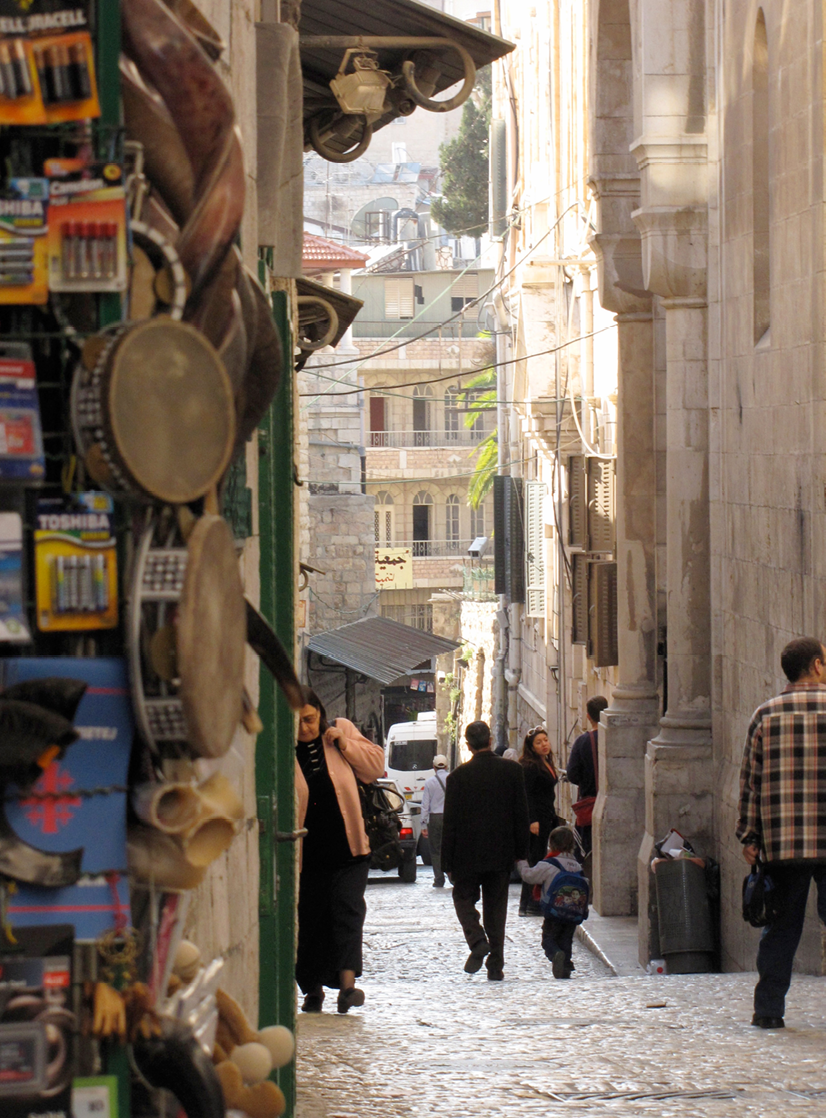
Jerusalem’s Old City (photo courtesy of acroll/Alistair)
I have never met Keller, but I did watch a recording of one of his talks. A lot of what he has to say is about evangelism, or winning additional converts to his religion. That’s not my favorite part of it, I must say. But he evinces an important understanding of what is special about contemporary urban life, including the following:
- Many cultural differences among people, requiring sensitivity;
- A heightened importance of work and career;
- An increased number of “edgy” people, who seek change;
- Artists, who have their own way of experiencing life; and
- The importance of helping the poor, and what he calls “justice and mercy” initiatives.
Because Keller wants the church to succeed, he urges people of faith not to seek to change city dwellers but to embrace the diversity and energy of city life and what makes urbanites different from their rural counterparts. Even those of us who are secular can benefit from Keller’s message of diversity, tolerance, and, ultimately, urbanism. For a start, how are we going to improve our communities if we do not try to understand each other? That seems at the heart of Keller’s message.
Another religious thinker and scholar, Eric Jacobsen, is senior pastor of First Presbyterian Church in Tacoma, Washington. His 2012 book, The Space Between: A Christian Engagement with the Built Environment, which I reviewed for the blog I write for NRDC, makes a very explicit case that people of faith have a special calling to care for cities. Further, Jacobsen believes—and I suspect Keller would agree—that the form of cities matters to the success of faithful practice.
I want to spend some time on The Space Between here, because I find its arguments revealing in their understanding of what makes cities work. If I could boil down Jacobsen’s theses into a few sentences, they would go something like this:
- Faith is not something you have but something you practice.
- The true practice of faith requires personal interaction with people and place.
- This practice is facilitated by cities, whose form and shape become critical to its success.
The book’s title comes from Jacobsen’s assertion that, when it comes to the physical form of communities, the spaces between the buildings matter as much as, and often more than, the buildings themselves. I agree. (There is also, of course, a Dave Matthews song of the same name, and a movie, but neither comes up.) He begins by observing that his belief about the importance of cities is not widely shared among Americans of faith, who increasingly see “community” as about relationships detached from particular geographic places. Indeed, the rise of ever-more-sophisticated communications technology and social media are reinforcing concepts of community divorced from place.
In addition, as Jacobsen elaborates later in the book, in the US cities are up against a deep-rooted anti-urban bias that dates back at least to Thomas Jefferson. Cities and the urban form tend to be neglected even by environmentalists, he asserts, because “green ideology is a rural agrarian ideology.” (He’s increasingly but not entirely wrong about that, in my opinion.) He believes this is mistaken given the relatively smaller environmental footprints of city dwellers, as David Owen’s book Green Metropolis, which Jacobsen quotes at some length, documents.

Copenhagen (photo courtesy of Payton Chung)
Jacobsen believes the Holy Bible is on the side of cities. He notes that the Bible repeatedly describes humans’ natural habitat and aspiration (even though beginning in the Garden of Eden) as in and toward cities:
“In John’s vision of the coming reign of Christ, he is given an evocative picture of our lives when our relationship with God is fully restored. And that picture is not of a garden or a wilderness, but of a city.”
Among many additional biblical references to cities, he later quotes the prophet Zechariah:
“Thus says the LORD of hosts: Old men and old women shall again sit in the streets of Jerusalem, each with staff in hand because of their great age. And the streets of the city shall be full of boys and girls playing in its streets.”
Central to The Space Between is the concept of shalom, which we usually translate simply as “peace” but which Jacobsen believes contains much more meaning, including restored fellowship, human flourishing, justice, and “relational wholeness” for everyone. He is not sparing in his measure of newer suburban development against that ideal: Jacobsen argues that, while each one of us carries a longing for shalom deep within, much of our recently built human settlement “bears not the slightest hint of that blessed condition that is described in the Bible.”
One of the ways in which we fail to move closer to shalom, he continues, is that today we experience our world not with our bodies and senses at human speeds, as Jacobsen believes God intended, but through automobiles and a world designed almost wholly to accommodate them. He cites several biblical passages that suggest something quite different, that walking is central to observant living.
In his chapter “A Theology of Place,” Jacobsen says that “place is an extremely important concept in the Bible,” particularly “enacted place[s],” those public spaces that draw people to animate them. Such spaces may be especially significant to the Christian community because people of faith are called to participate in public life as witnesses and ambassadors. Gathered worship is an important part of faithful life, and we should consider how our religious expression extends to the public realm.
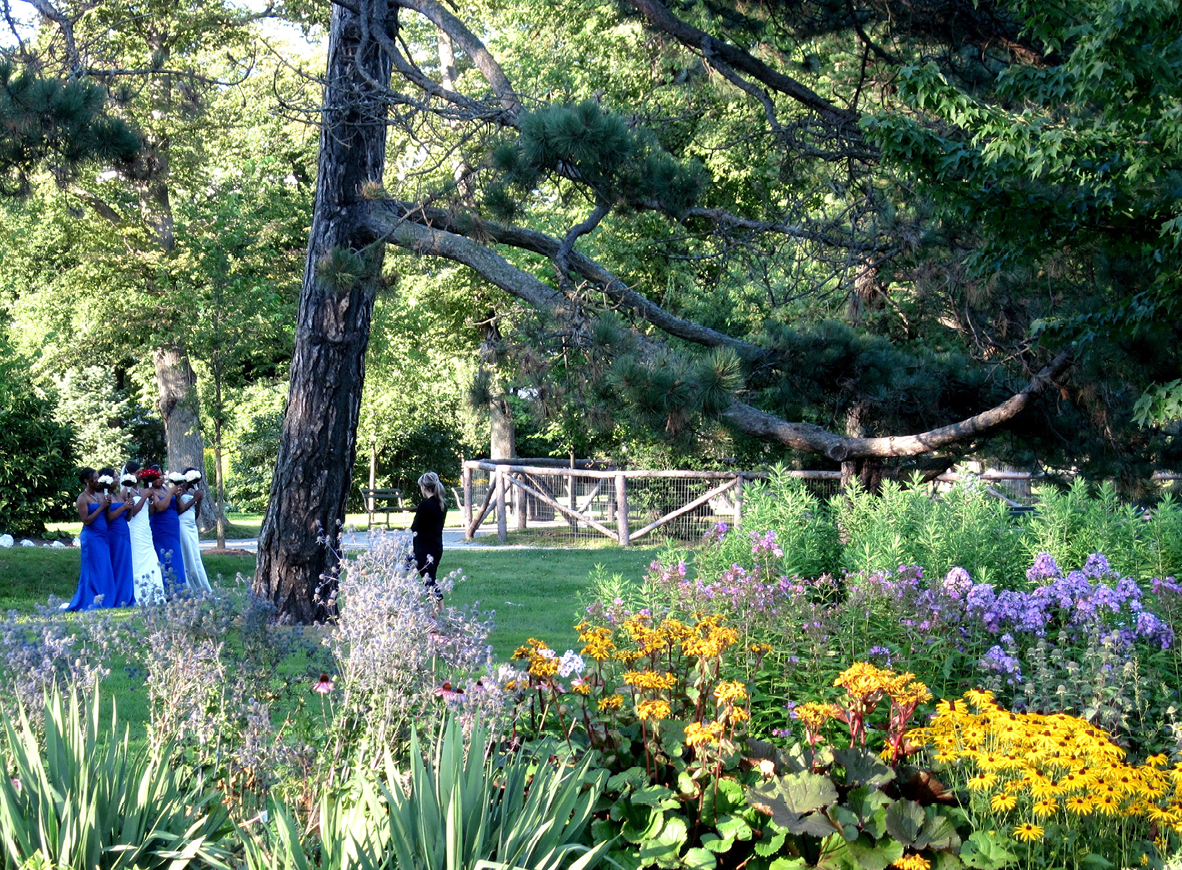
Halifax, Nova Scotia (photo by F. Kaid Benfield)
Jacobsen also believes that faith calls us to honor the importance of place with respect to such elusive concepts as legacy, lovability, and beauty. On legacy, for example, he notes that the church in which he was baptized still stands today, symbolizing that his baptism was not just an isolated act but a continuation of longstanding culture and tradition. On lovability, he quotes G.K. Chesterton, who said that the city of Rome did not become loved because it was great but, rather, that it became great because it was loved. I think I am with Jacobsen on this.
I was particularly struck by the chapter titled “A Theology of Beauty,” in which Jacobsen notes that the New Revised Standard Version of the Bible mentions “beauty” or “beautiful” 90 times. I was pleasantly shocked to see the famous 16th-century Protestant reformer John Calvin, who even disdained music in his Geneva services and generally is thought of as having been ascetic and severe, quoted at length on the subject:
“Now if we ponder to what end God created food, we shall find that he meant not only to provide for necessity but also for delight and good cheer. Thus the purpose of clothing, apart from necessity, was comeliness and decency. In grasses, trees, and fruits, apart from their various uses, there is beauty of appearance and pleasantness of odor…Has the Lord clothed the flowers with the great beauty that greets our eyes, the sweetness of smell that is wafted upon our nostrils, and yet will it be unlawful for our eyes to be affected by that beauty, or our sense of smell by the sweetness of that odor?”
I thought I knew my Protestant history, but I had no idea.
Jacobsen even goes so far as to state that “one of the elements that distinguishes Christianity from some of the major Eastern religions (Buddhism, for instance) is its basic affirmation of sensuous desire.” (That statement certainly confirms that Jacobsen could not possibly have grown up, as I did, in the church culture of Asheville, North Carolina in the 1960s. As for Eastern religions and sensuality, I would gently suggest that the ancient Hindu text Kama Sutra is far more instructive on these matters than anything I learned in my Methodist Youth Fellowship.)
Jacobsen strongly identifies with the new urbanist school of architecture and planning but ultimately concludes that even the best elements of physical urban form cannot in themselves create true community. He contrasts the architectural success but social limitations of the iconic new urbanist development Seaside, in Florida, with the messier but more genuine and organic city of Missoula, where he formerly lived:
“Missoula has the advantage over Seaside of a permanent community of residents who can use whatever urban amenities are available as a loom upon which they can weave the fabric of the community together. And Missoula has the advantage of having, interspersed throughout the city, a number of significant churches with active congregations who help to anchor and give depth to the urban texture…
“To understand these inhibitors to and incubators for human community, the New Urbanist movement will have to look beyond its vanguard of architects, builders, and government workers. New Urbanism will have to begin to listen to the voices of teachers, psychologists, and, yes, even pastors if it ever hopes to become more than a market correction and instead be the long-term cultural project to which it aspires.”
If Keller and Jacobsen both make a strong case that cities are important to faithful practice, Jacobsen also articulates why he believes that religion is important to cities. Churches play a unique role in fostering community, Jacobsen argues, because they set a “living tradition” of predictable and periodic ritual that goes back generations. Even a new church in a new residential area “can tie the neighborhood into a tradition that is thousands of years old and can bring much-needed depth and perspective into a community. A local congregation can also provide a witness of permanence and connection among the disparate individuals within a community.”
Jacobsen much prefers that, for churches to function well, they be located in a community’s center or at least integrated into their neighborhoods.
Perhaps the most important part of Jacobsen’s writing asserts that faith requires its adherents to be welcoming of strangers, reeling off several citations to biblical passages that support his point. (Along with being a planning aficionado, Jacobsen may also have a lawyerly streak within him.) He believes that our patterns of development stand in the way, especially with exclusionary zoning and abandonment of the public realm in newer suburbs, which work against relationships even among familiar neighbors “when everyone enters their homes through the garage door and spends time indoors or in the back yard.” Families with kids tend to mitigate this, Jacobsen allows, but it’s one more set of barriers for everyone else.
So what about those who are less well off? Justice is an important biblical concept, Jacobsen writes, especially for the poor and most vulnerable members of our society. He quotes Isaiah in what appears to be a prophetic (heh) admonition against exclusionary zoning and sprawl:
“Ah, you who join house to house, who add field to field, until there is room for no one but you, and you are left to live alone in the midst of the land!”
As my own writings do, The Space Between struggles with the troubling issues of gentrification and displacement as formerly disinvested city neighborhoods revitalize. (See the discussion above in Chapter 5.) Jacobsen makes a critical point when he notes that some of the logic behind the anti-gentrification argument is disturbing in that, extended, it suggests “that we should keep certain neighborhoods dangerous, dirty, and ill maintained” so that property values would not increase and no one of means would choose to live there. He cites some hopeful research to the effect that stagnant neighborhoods that fail to improve are actually less able to retain long-term residents than those that do. Jacobsen doesn’t pretend to have all the answers, but does propose that it is important to maintain different types of housing—apartments, townhomes, and single-family homes of various sizes and price points—in a neighborhood in order to achieve a mixed-income outcome. I couldn’t agree more.
The Space Between concludes with a wonderfully titled chapter, “A Geography of Rest.” The idea is that what Jacobsen calls “Sabbath practice” should not be confined to the Sabbath day, and that our human habitats must provide us with “places that invite us to rest and to engage with one other and with the world that surrounds us without demanding that we give something productive in return.” These, he argues, are places of shalom. Cities must provide them, Jacobsen argues, “to provide a tacit reminder of what is important.”
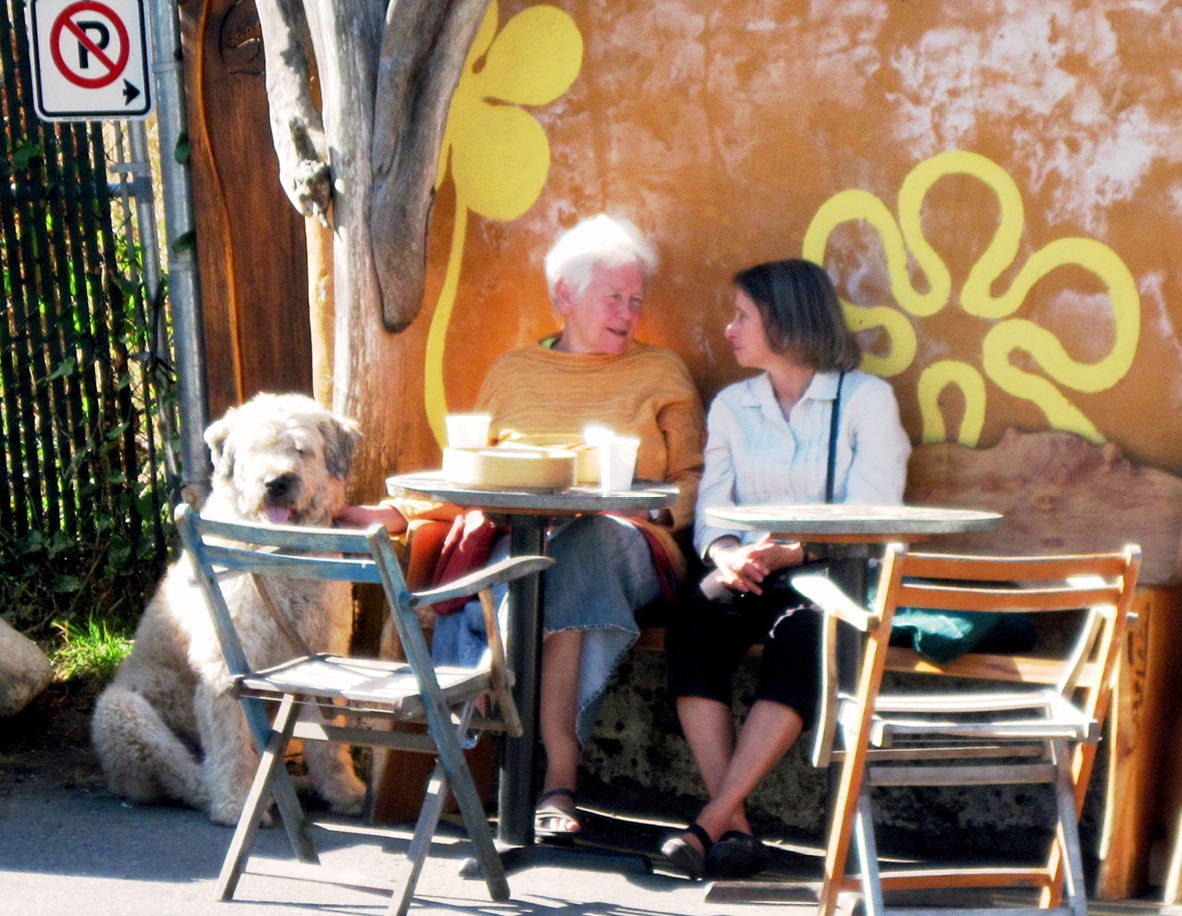
Fulford Harbor, British Columbia (photo by F. Kaid Benfield)
Although the thinkers whose views I have discussed in this chapter are Christian, I do not mean to say that linking cities and religion is solely or primarily a Christian issue. I had the honor in 2009 of interviewing Michael Abbaté, author of the book Gardening Eden and a city planner as well as religious thinker. In our interview, Abbaté emphasized that caring for the environment—whether it is urban, suburban, rural, or something else—can be a bridge connecting people of different faiths:
“The faith I know best is Christianity, but Judaism and Islam also share a heritage that reaches back to a personal Creator God who gave us a spiritual reason for caring for the environment. Buddhism and Hinduism, though different in their beliefs about the essence of God, also recognize that humans and the earth are linked in ways more profound than simply our physical needs. One of the points of Gardening Eden is that environmental stewardship is not, first and foremost, a political issue; it is a personal and spiritual one.”
Religious or not, you have to love that paragraph and, especially, that closing.
So where does all this theology leave us? In my case, I would say that it leaves me hopeful. Knowing there are religious leaders out there preaching the urban gospel as well as the biblical one is encouraging to someone who wants to see cities become mainstream again. It is invigorating to see urbanist concepts examined in a new context. Ours remains a very religious country: three-quarters of Americans identify as Christian and an even stronger majority claim some type of spiritual faith. What people of faith believe, think, and practice is important to our future, and thus to the future of human settlement.
More about Faith in the City
The Boston Project Ministries
I met Paul Malkemes in the fall of 2012 while doing some work in a low-income neighborhood in Boston. I was impressed: for Paul and his wife Glenna, helping make their highly urban and distressed neighborhood—and others like it—better and greener was not just something they did as part of their religious practice; it was their religious practice.
In particular, the Malkemeses were working under the banner of a faith-based organization they founded, The Boston Project Ministries. The Project’s website says it is “a community-based organization in Boston with a passion for seeing renewal in urban neighborhoods,” and that is exactly what our team witnessed when we visited. (We were in the Talbot-Norfolk Triangle (TNT) area of Boston’s Dorchester district, helping the neighborhood undertake sustainability planning.)
One of the Boston Project’s most important undertakings is helping bring a network of pocket parks and other green space into the neighborhood. Its website enthusiastically articulates the goal:
“A multi-site urban garden will transform the TNT neighborhood by creating a walkable route that connects green spaces in the community. Planned play areas, passive parks, urban gardens and orchards are a few of the projects neighbors want to see come to fruition! A multi-site urban garden will:
- Preserve urban green space and provide balance in an area marked by active housing development. TNT has 300 housing units (source: 2000 census), with plans for a potential 100+ additional units in the next 2-4 years.
- Promote physical activity and neighbor interaction. Neighbors of all ages will be able to relax, converse, play and learn in new open, green areas.
- Encourage healthier eating. The community garden will encourage and facilitate eating fresh, local food.
- Provide learning opportunities. Collaborations with urban green space groups and local schools will bring learning opportunities to our neighborhood.
- Engage youth in employment opportunities. Environmentally-focused internships for teens will provide youth opportunities to learn skills to equip them for work in the green economy while furthering the goals of the TNT Green Space Master Plan.
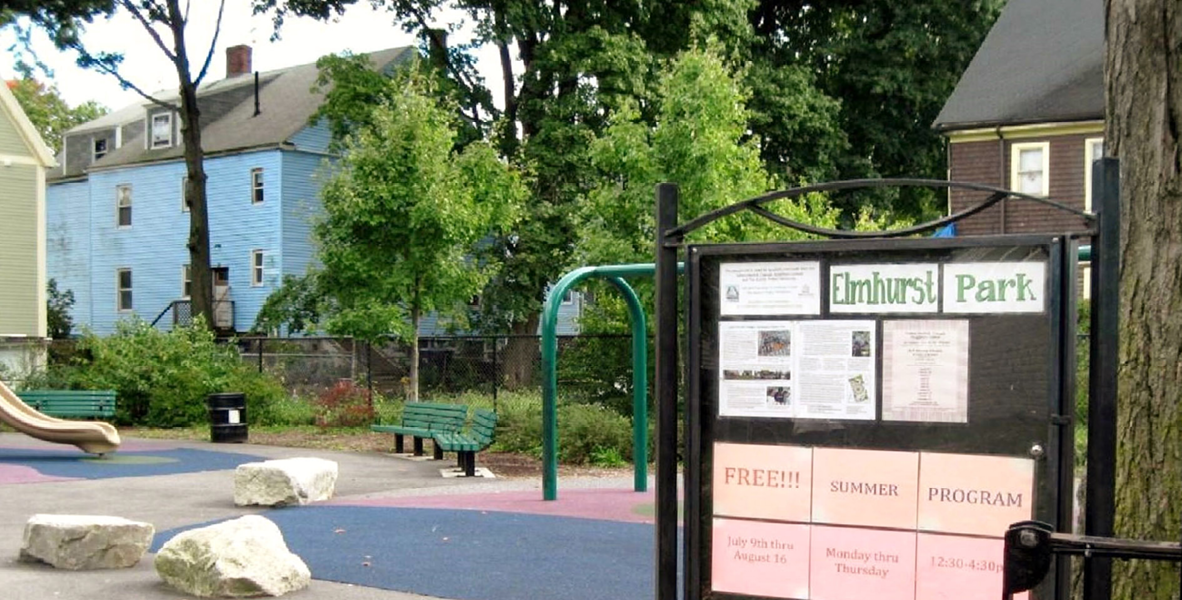
Elmhurst Park, Boston (photo by F. Kaid Benfield)
Inspire community pride!”
The organization has a ten-year plan for converting small, publicly owned vacant lots scattered around the neighborhood into green “islands” to be enjoyed by the community. As the site notes, these spaces will benefit not only current residents but also new households, which the neighborhood anticipates as a result of a new transit station opened in late 2012.
We stopped at Elmhurst Park, a new children’s park that had been catalyzed by the Boston Project’s advocacy. (The Project was fortunate to be joined in that effort by—in addition to other neighborhood, philanthropic, and municipal partners—the Trust for Public Land, which has long had a terrific program for city parks.) Kids had painted expressions of neighborhood pride (“Together we can make a change!”) around the park’s perimeter.
Impressively, the Boston Project Ministries are administered from the Malkemeses’ house near Elmhurst Park. The house itself is significant: Paul, Glenna, and their family live upstairs, but they have made the first floor available as community space. The highlight is a free, pleasant, and safe drop-in center where youth can come and go at their leisure to do homework or enjoy fellowship. Any neighborhood would benefit from this kind of leadership, and I suspect that Keller, Jacobsen, and Abbaté would approve wholeheartedly.